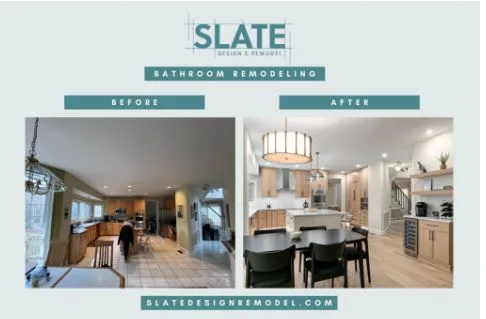Basement Remodel Before and After
Every home has a story, and the basement is often the unwritten chapter. Basements are frequently left unfinished, used solely for storage, or ignored as a waste of space. However, with the right vision, this hidden part of the house can be transformed into something extraordinary, whether it’s a cozy family retreat, a state-of-the-art home theater, or even a stylish guest suite.
This is where basement renovations become truly inspirational. The difference between “before” and “after” is more than just visual; it’s about realizing potential and creating a space that adds value to daily life. With the help of professionals like Slate Design & Remodel, homeowners can see their basements transform from dark and underutilized to bright, functional, and beautifully designed. To truly appreciate these transformations, it’s important to understand the challenges most basements face before remodeling.
Common Basement Challenges Before Remodeling
Before we admire the “after,” let’s take a closer look at the “before.” Most basements face a number of challenges that make them less appealing or functional as a part of the home. These issues frequently discourage homeowners from fully utilizing the space; however, they also highlight how dramatic the transformation can be.
• Underutilized or cluttered spaces
Many basements are used as general storage areas for old furniture, boxes, and seasonal items. This results in a space that feels more like a forgotten storage unit than an extension of the home’s living area. A remodel removes the clutter and reimagines the layout, making the basement functional and inviting.
• Moisture and dampness issues
Basements are susceptible to leaks, condensation, and musty odors due to their location underground. If left unaddressed, these problems not only reduce comfort but also damage flooring, walls, and belongings. A remodel usually includes waterproofing solutions that transform a damp, unwelcoming basement into a clean, dry, and comfortable environment.
• Poor lighting and low ceilings
Basements frequently lack natural light and have low ceiling heights, making the space feel dark and confined. Remodeling introduces brighter lighting, creative ceiling designs, and reflective finishes to help open up the space visually.
• Outdated finishes and materials
Old carpeting, wood paneling, and linoleum floors are common in older basements. These dated features give the area a neglected feel. A remodel replaces outdated materials with modern, durable, and stylish finishes, immediately elevating the atmosphere.
These challenges explain why many homeowners do not spend much time in their basements. However, they also lay the groundwork for the spectacular “after” results that a professional remodel can provide. And it all begins with a solid plan, which is where we’ll go next.
Planning a Successful Basement Remodel
Once the common challenges of basements have been identified, the next step is to plan how to overcome them. A remodel does not begin with tearing down walls or selecting flooring; it starts with careful planning. During this stage, homeowners set the tone for the transformation and ensure the final “after” matches their vision and needs.
The first step in planning is determining the purpose of the basement. Will it function as a family entertainment room, a guest suite, a personal gym, or a home office? Knowing the intended function helps guide all subsequent decisions, from layout to finishes. For example, a home theater may prioritize soundproofing and comfortable seating, whereas a guest suite would prioritize warmth, privacy, and a bathroom addition.
Budgeting is another critical component of planning. A remodel’s cost can vary greatly depending on the level of finishes and features. Establishing a realistic budget early on allows homeowners to prioritize necessary upgrades without going overboard financially. It also identifies areas where they may want to invest more, like high-quality flooring or custom cabinetry, and where they can opt for cost-effective alternatives.
Then comes the layout and design planning. A basement remodel is more than just adding new materials; it’s also about making the most of the available space. Proper zoning, for example, separates a lounge area from a playroom or gym, making the space feel organized and intentional rather than cluttered. Design planning also considers natural light sources, traffic flow, and how the basement will connect with the rest of the home.
This is where a professional remodeler, such as Slate Design & Remodel, can really help. Their experience assessing basement conditions, resolving common issues such as moisture, and tailoring designs to specific requirements ensures that the project gets off to a good start. With their help, planning goes from overwhelming to empowering.
Once the vision and budget are established, the exciting part begins: choosing the appropriate materials and features to bring the plan to life.
Choosing Materials and Features for a Basement Transformation
With the vision and layout established, the next step is to decide on the materials and features that will define the basement’s “after.” The right decisions not only improve aesthetics but also ensure durability in a space that comes with its own set of challenges, such as moisture, limited light, and cooler temperatures.
Flooring is one of the most important decisions. Basements, unlike other areas of the home, benefit from humidity-resistant materials. Luxury vinyl planks, engineered wood, and tile are popular because they offer both durability and style. Carpet tiles are an excellent choice for adding warmth while remaining easy to replace if necessary.
Walls and ceilings play an important role in transformation. To achieve a clean, modern look, replace outdated wood paneling or concrete walls with drywall. Some homeowners choose creative ceiling solutions, such as painted exposed beams for an industrial look or drop ceilings for easy access to wiring and plumbing. Proper insulation is also key here, ensuring year-round comfort.
Lighting, too, requires special attention. Recessed lighting, wall sconces, and strategically placed lamps help to brighten basements, which often lack natural light. Combining these with lighter paint colors or reflective finishes can make the basement appear larger and more open.
Then there are the features that elevate a basement from functional to exceptional. A wet bar, built-in shelving, a home theater system, or even a full bathroom can all significantly improve usability and value. These additions should align with the purpose defined during planning, ensuring that they meet both lifestyle needs and budget constraints.
At this point, homeowners can see their basement’s potential taking shape. Once the materials and features are selected, the transformation process enters its most exciting stage: Visualizing the dramatic before and after changes
Real-Life Case Studies: Before and After Basement Remodels
Seeing actual transformations is one of the most effective ways to understand the impact of a basement remodel. Photos and stories from homeowners demonstrate how a once-forgotten space can be transformed into the heart of the home. These case studies also demonstrate the creativity and craftsmanship of professional remodelers such as Slate Design & Remodel, who specialize in customizing each basement to the homeowner’s lifestyle.
One example is a dark, unfinished basement that was used primarily for storage. Exposed pipes, concrete floors, and poor lighting rendered it unusable. After remodeling, it was transformed into a bright, multifunctional family room with durable flooring, recessed lighting, and custom shelving. The “after” not only improved daily life, but also significantly increased the value of the home.
In another project, an outdated basement with old carpeting and paneling was converted into a modern guest suite. By adding a bathroom, fresh paint, and new flooring, the homeowners created a welcoming environment for visitors. What was previously avoided has become one of the most welcoming aspects of the home.
Some remodels even transform basements into entertainment centers, complete with wet bars, large-screen TVs, and surround sound systems. The contrast between an empty, dim basement and a bustling gathering area is frequently the most striking. These examples demonstrate that a remodel isn’t just about aesthetics, it’s about designing spaces that meet personal needs and lifestyle goals.
Looking at these real-world projects helps homeowners visualize what is possible in their own homes. In addition to inspiration, these transformations provide a strong return on investment.
The Value of Basement Remodels: Beyond Aesthetics
While the visual impact of a remodel is undeniable, the true value of a basement renovation extends far beyond appearances. Homeowners who invest in this type of project frequently discover that the benefits include increased comfort, lifestyle, and even financial gain.
One of the most significant advantages is increased livable space. Instead of leaving the basement as a neglected area, remodeling transforms it into usable space. Whether it becomes a family room, a rental suite, or a dedicated office, the basement begins to serve a practical purpose in everyday life. This added functionality can dramatically improve the overall feel and function of the home.
Another significant benefit is an increase in property value. A well-designed basement remodel can significantly increase a home’s resale value, with one of the highest returns on investment among remodeling projects. Buyers prefer homes with finished basements because they are move-in ready and versatile.
Beyond the financial benefits, there is also an increase in comfort and efficiency. Modern remodels frequently include insulation, waterproofing, and energy-efficient systems, making the basement not only more pleasant but also less expensive to maintain. A space that was previously damp and cold can be transformed into a warm, inviting retreat.
Of course, there is emotional value. Previous case studies demonstrate how homeowners feel proud of their renovated basements. What was once hidden away is now a place where families gather, friends are entertained, and quiet moments of relaxation occur.
When we consider all of these advantages, practical, financial, and personal, it’s clear why basement remodels are so effective. For homeowners who want to begin their own transformation, working with an experienced remodeler is the next step.
Why Choose Slate Design & Remodel for Your Basement Transformation
When it comes to transforming an ordinary basement into something extraordinary, hiring the right remodeler is critical. Basement challenges, moisture, low ceilings, and limited light, require more than cosmetic updates. They necessitate expertise, creativity, and meticulous planning. That’s precisely what Slate Design & Remodel brings to each project.
What distinguishes Slate Design & Remodel is their ability to combine functionality with style. They don’t just remodel basements; they design spaces that reflect each homeowner’s style, whether it’s a cozy family lounge, a sleek home office, or a guest suite complete with all of the amenities of home. Every detail, from the choice of flooring to the lighting layout, is tailored to ensure the final space feels purposeful and welcoming.
Another reason homeowners trust Slate Design & Remodel is their dedication to quality and transparency. From the first consultation to the final walkthrough, they prioritize clear communication, realistic budgeting, and high-quality craftsmanship. This ensures both a smooth remodeling process and long-lasting results.
Most importantly, Slate Design & Remodel understands that a basement remodel is more than a renovation; it is an investment in your lifestyle. They help families unlock new possibilities, increase property value, and create spaces that inspire pride by reimagining this often-overlooked aspect of the home. Anyone willing to take the plunge and see their own basement “before and after,” Slate Design & Remodel is the trusted partner to bring that vision to fruition.




